Resource retrieval
Get the pre-trained net:
| Out[1]= |  |
NetModel parameters
This model consists of a family of individual nets, each identified by a specific parameter combination. Inspect the available parameters:
| Out[2]= |  |
Pick a non-default net by specifying the parameters:
| Out[3]= |  |
Pick a non-default uninitialized net:
| Out[4]= |  |
Basic usage
Given a piece of text, the GPT-2 net produces a sequence of feature vectors of size 768, which correspond to the sequence of input words or subwords:
| Out[5]= |  |
Obtain dimensions of the embeddings:
| Out[6]= |  |
Visualize the embeddings:
| Out[7]= |  |
Transformer architecture
The input string is first normalized and then tokenized, or split into words or subwords. This two-step process is accomplished using the NetEncoder "Function":
| Out[8]= |  |
The tokenization step is performed using the NetEncoder "BPESubwordTokens" and can be extracted using the following steps:
| Out[10]= | 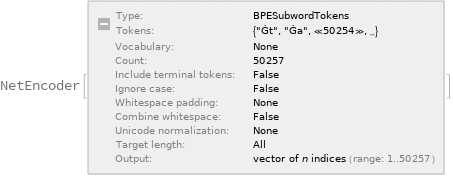 |
The encoder produces an integer index for each subword token that corresponds to the position in the vocabulary:
| Out[11]= |  |
Each subword token is also assigned a positional index:
| Out[12]= |  |
A lookup is done to map these indices to numeric vectors of size 768:
| Out[14]= |  |
For each subword token, these two embeddings are combined by summing elements with ThreadingLayer:
| Out[15]= | 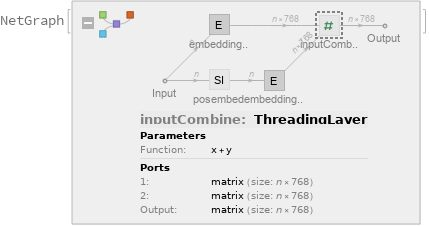 |
The transformer architecture then processes the vectors using 12 structurally identical self-attention blocks stacked in a chain:
| Out[16]= |  |
The key part of these blocks is the attention module comprising of 12 parallel self-attention transformations, also called “attention heads”:
| Out[17]= | 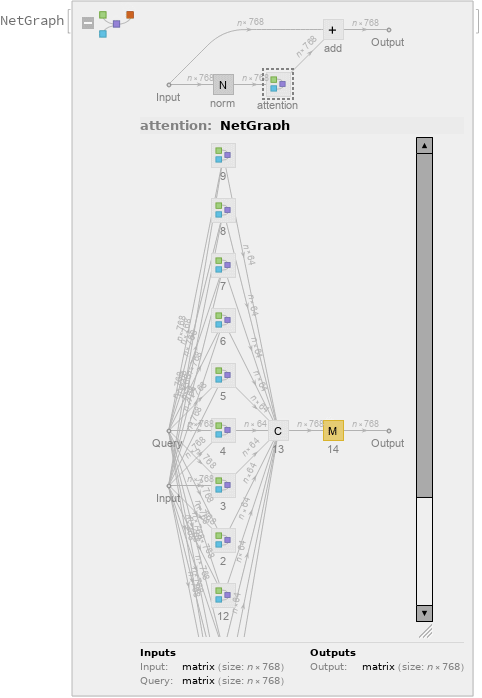 |
Each head uses an AttentionLayer at its core:
| Out[18]= | 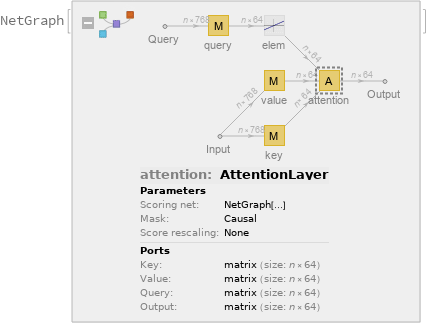 |
Attention is done with causal masking, which means that the embedding of a given subword token depends on the previous subword tokens and not on the next ones.
This is a prerequisite to be able to generate text with the language model. The following figures compare causal attention to other forms of connectivity between input tokens:
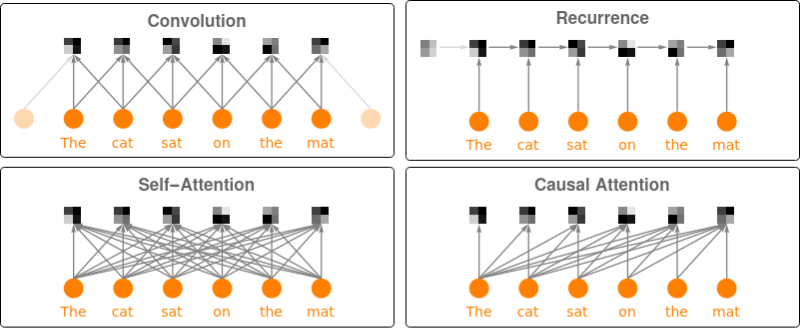
Language modeling: Basic usage
Retrieve the language model by specifying the "Task" parameter:
| Out[19]= |  |
Predict the next word in a given sequence:
| Out[20]= |  |
Obtain the top 15 probabilities:
| Out[21]= |  |
Plot the top 15 probabilities:
| Out[22]= | 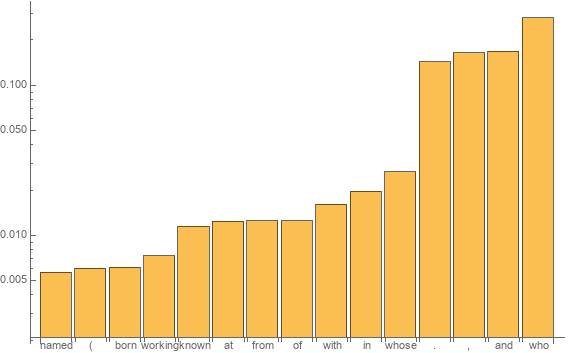 |
Text generation
Define a function to predict the next token:
Generate the next 20 tokens by using it on a piece of text:
| Out[24]= |  |
The third optional argument is a “temperature” parameter that scales the input to the final softmax. A high temperature flattens the distribution from which tokens are sampled, increasing the probability of extracting less likely tokens:
| Out[25]= |  |
Decreasing the temperature sharpens the peaks of the sampling distribution, further decreasing the probability of extracting less likely tokens :
| Out[26]= |  |
Very high temperature settings are equivalent to random sampling:
| Out[27]= |  |
Very low temperature settings are equivalent to always picking the character with maximum probability. It is typical for sampling to “get stuck in a loop”:
| Out[28]= |  |
Sentence analogies
Define a sentence embedding that consists of the last subword embedding of GPT-2 (this choice is justified by the fact that GPT-2 is a forward causal model):
| Out[29]= |  |
Define some sentences in two broad categories for comparison:
Precompute the embeddings for a list of sentences:
Visualize the similarity between the sentences using the net as a feature extractor:
| Out[32]= | 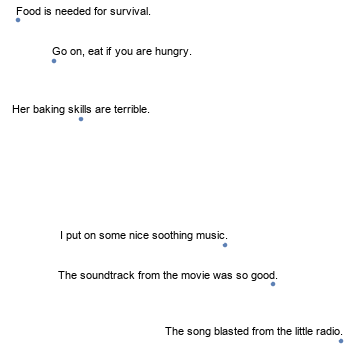 |
Train a classifier model with the subword embeddings
Get a text-processing dataset:
View a random sample of the dataset:
| Out[34]= |  |
Define a sentence embedding that consists of the last subword embedding of GPT-2 (this choice is justified by the fact that GPT-2 is a forward causal model):
| Out[35]= |  |
Precompute the GPT-2 vectors for the training and the validation datasets (if available, GPU is recommended), using the last embedded vector as a representation of the entire text:
Define a simple network for classification:
| Out[37]= |  |
Train the network on the precomputed GPT-2 vectors :
| Out[38]= | 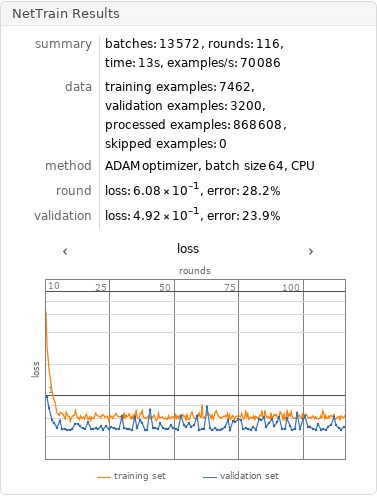 |
Check the classification error rate on the validation data:
| Out[39]= |  |
Compare the results with the performance of a classifier trained on context-independent word embeddings. Precompute the GloVe vectors for the training and the validation datasets (if available, GPU is recommended):
Define a simple network for classification, using a max-pooling strategy:
| Out[42]= |  |
Train the classifier on the precomputed GloVe vectors:
| Out[43]= | 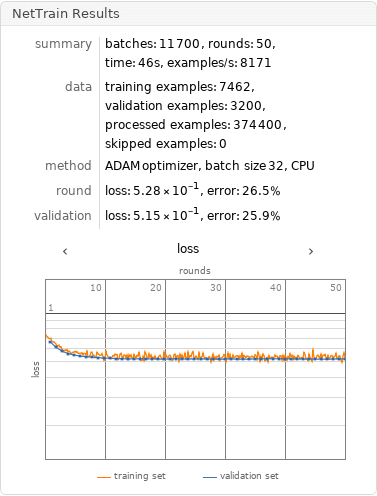 |
Compare the results obtained with GPT-2 and with GloVe:
| Out[44]= |  |
Net information
Inspect the number of parameters of all arrays in the net:
| Out[45]= |  |
Obtain the total number of parameters:
| Out[46]= |  |
Obtain the layer type counts:
| Out[47]= |  |
Display the summary graphic:
| Out[48]= |  |
Export to MXNet
Export the net into a format that can be opened in MXNet:
| Out[49]= |  |
Export also creates a net.params file containing parameters:
| Out[50]= |  |
Get the size of the parameter file:
| Out[51]= |  |








![embeddings = net["Hello world! I am here",
{NetPort[{"embedding", "embeddingpos", "Output"}],
NetPort[{"embedding", "embeddingtokens", "Output"}]}];
Map[MatrixPlot, embeddings]](images/1a8/1a862f5a-61ec-46fe-975a-c9c7e36a5098-io-13-i.en.gif)









![lm = NetModel[{"GPT-2 Transformer Trained on WebText Data",
"Task" -> "LanguageModeling"}];
generateSample[languagemodel_][input_String, numTokens_: 10,
temperature_: 1] :=
Nest[Function[
StringJoin[#,
languagemodel[#, {"RandomSample",
"Temperature" -> temperature}]]], input, numTokens];](images/1a8/1a862f5a-61ec-46fe-975a-c9c7e36a5098-io-23-i.en.gif)








![classifierhead = NetChain[
{DropoutLayer[], 2, SoftmaxLayer[]},
"Output" -> NetDecoder[{"Class", {"negative", "positive"}}]
]](images/1a8/1a862f5a-61ec-46fe-975a-c9c7e36a5098-io-37-i.en.gif)

![gpt2results = NetTrain[classifierhead, trainembeddings, All,
ValidationSet -> validembeddings,
TrainingStoppingCriterion -> <|"Criterion" -> "ErrorRate",
"Patience" -> 50|>,
TargetDevice -> "CPU",
MaxTrainingRounds -> 500]](images/1a8/1a862f5a-61ec-46fe-975a-c9c7e36a5098-io-38-i.en.gif)

![gloveclassifierhead = NetChain[
{DropoutLayer[],
NetMapOperator[2],
AggregationLayer[Max, 1],
SoftmaxLayer[]},
"Output" -> NetDecoder[{"Class", {"negative", "positive"}}]]](images/1a8/1a862f5a-61ec-46fe-975a-c9c7e36a5098-io-42-i.en.gif)

![gloveresults = NetTrain[gloveclassifierhead, trainembeddingsglove, All,
ValidationSet -> validembeddingsglove,
TrainingStoppingCriterion -> <|"Criterion" -> "ErrorRate",
"Patience" -> 50|>,
TargetDevice -> "CPU",
MaxTrainingRounds -> 50]](images/1a8/1a862f5a-61ec-46fe-975a-c9c7e36a5098-io-43-i.en.gif)



